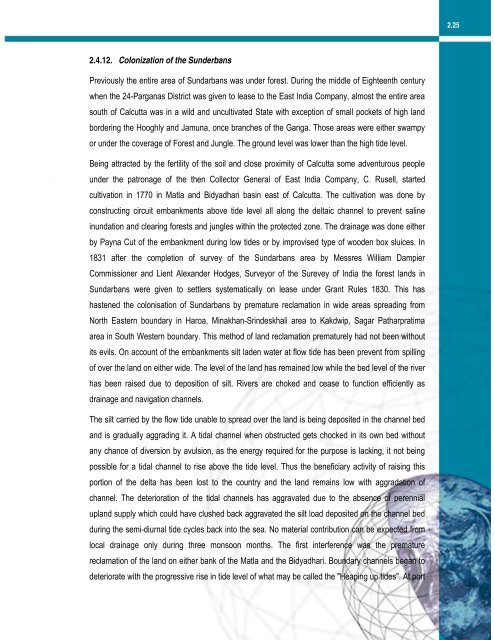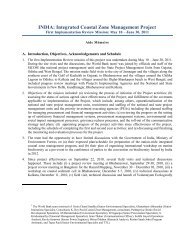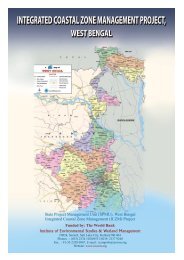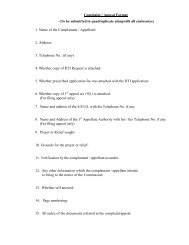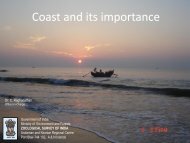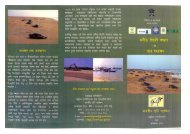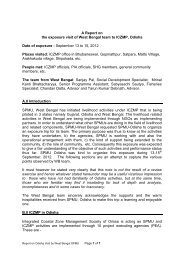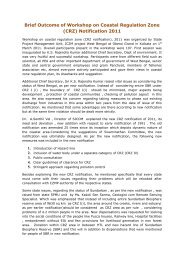Cyclone and Storm Surge - Iczmpwb.org
Cyclone and Storm Surge - Iczmpwb.org
Cyclone and Storm Surge - Iczmpwb.org
You also want an ePaper? Increase the reach of your titles
YUMPU automatically turns print PDFs into web optimized ePapers that Google loves.
2.25<br />
2.4.12. Colonization of the Sunderbans<br />
Previously the entire area of Sundarbans was under forest. During the middle of Eighteenth century<br />
when the 24-Parganas District was given to lease to the East India Company, almost the entire area<br />
south of Calcutta was in a wild <strong>and</strong> uncultivated State with exception of small pockets of high l<strong>and</strong><br />
bordering the Hooghly <strong>and</strong> Jamuna, once branches of the Ganga. Those areas were either swampy<br />
or under the coverage of Forest <strong>and</strong> Jungle. The ground level was lower than the high tide level.<br />
Being attracted by the fertility of the soil <strong>and</strong> close proximity of Calcutta some adventurous people<br />
under the patronage of the then Collector General of East India Company, C. Rusell, started<br />
cultivation in 1770 in Matla <strong>and</strong> Bidyadhari basin east of Calcutta. The cultivation was done by<br />
constructing circuit embankments above tide level all along the deltaic channel to prevent saline<br />
inundation <strong>and</strong> clearing forests <strong>and</strong> jungles within the protected zone. The drainage was done either<br />
by Payna Cut of the embankment during low tides or by improvised type of wooden box sluices. In<br />
1831 after the completion of survey of the Sundarbans area by Messres William Dampier<br />
Commissioner <strong>and</strong> Lient Alex<strong>and</strong>er Hodges, Surveyor of the Surevey of India the forest l<strong>and</strong>s in<br />
Sundarbans were given to settlers systematically on lease under Grant Rules 1830. This has<br />
hastened the colonisation of Sundarbans by premature reclamation in wide areas spreading from<br />
North Eastern boundary in Haroa, Minakhan-Srindeskhali area to Kakdwip, Sagar Patharpratima<br />
area in South Western boundary. This method of l<strong>and</strong> reclamation prematurely had not been without<br />
its evils. On account of the embankments silt laden water at flow tide has been prevent from spilling<br />
of over the l<strong>and</strong> on either wide. The level of the l<strong>and</strong> has remained low while the bed level of the river<br />
has been raised due to deposition of silt. Rivers are choked <strong>and</strong> cease to function efficiently as<br />
drainage <strong>and</strong> navigation channels.<br />
The silt carried by the flow tide unable to spread over the l<strong>and</strong> is being deposited in the channel bed<br />
<strong>and</strong> is gradually aggrading it. A tidal channel when obstructed gets chocked in its own bed without<br />
any chance of diversion by avulsion, as the energy required for the purpose is lacking, it not being<br />
possible for a tidal channel to rise above the tide level. Thus the beneficiary activity of raising this<br />
portion of the delta has been lost to the country <strong>and</strong> the l<strong>and</strong> remains low with aggradation of<br />
channel. The deterioration of the tidal channels has aggravated due to the absence of perennial<br />
upl<strong>and</strong> supply which could have clushed back aggravated the silt load deposited on the channel bed<br />
during the semi-diurnal tide cycles back into the sea. No material contribution can be expected from<br />
local drainage only during three monsoon months. The first interference was the premature<br />
reclamation of the l<strong>and</strong> on either bank of the Matla <strong>and</strong> the Bidyadhari. Boundary channels began to<br />
deteriorate with the progressive rise in tide level of what may be called the "Heaping up tides". At port


